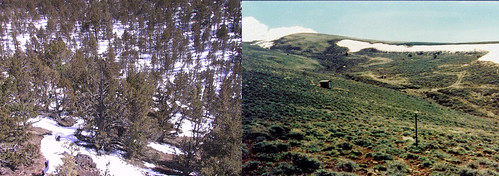
Removing invading conifer trees improves the health of sagebrush ecosystems, providing better habitat for wildlife and better forage for livestock. And now, new science shows these efforts may also help improve late-season water availability, which is crucial for ecosystems in the arid West.
According to the Sage Grouse Initiative (SGI)’s newest Science to Solutions report – which summarized research from USDA’s Agricultural Research Service (ARS) – a sagebrush-dominated watershed holds water in snow drifts an average of nine days longer than one dominated by juniper trees.
Why is holding snow important for rangelands?
In the West, most precipitation comes in the form of snow. Having snow on the landscape longer gives water more time to slowly seep into the ground, providing more water in the soil at critical times for plants, sustaining wet meadow areas, and increasing late-season streamflow.
ARS researchers compared snow and streamflow data from sagebrush- versus juniper-dominated watersheds over the span of six years in the Owyhee Mountains of southwestern Idaho. Their goal was to better understand how juniper affects water availability. Working with physical data from four weather stations in the mountains, the researchers used iSnoball to model and estimate the amount of snow accumulated and how fast it melted in both juniper and sagebrush landscapes.

Why does snow melt slower in sagebrush?
A wide-open sagebrush landscape has higher wind speeds, causing snow to pile up deeper in different areas. This uneven distribution causes snow to melt at different rates and, in some areas, hold water for longer periods of time.
What are the benefits of snow in sagebrush?
Since parts of the sagebrush landscape hold water longer, the soil has more water available later in the season to grow “green groceries” – succulent grasses and wildflowers that make for high quality habitat and grazing lands. This ARS research also shows that snow-covered, sagebrush-dominated watersheds are better at turning limited precipitation into streamflow. Timing of snowmelt influences riparian and wet meadow areas that are critical for many species, including sage grouse, as the arid sagebrush ecosystem dries up during the summer.
What are we doing to help?
Over the last 150 years, the amount of conifers in the sagebrush sea has increased by up to 625 percent because of a combination of factors. This encroachment by junipers and other species has been detrimental to the ecosystem.
Through SGI, a partnership led by USDA’s Natural Resources Conservation Service (NRCS), ranchers and conservation partners are expanding sagebrush habitat by strategically removing conifers to preserve native grasses, wildflowers, and shrubs. This keeps the sagebrush sea intact and viable for wildlife and ranching operations. Research now confirms conifer removal benefits sage grouse and other sagebrush-dependent species. Plus, it makes rangelands more resilient to wildfire and more resistant to invasive weeds.
Conifer expansion is one of the five primary threats targeted by the agency’s Sage Grouse Initiative 2.0 investment strategy, which strategically directs conservation efforts where the returns on investment are highest.
Want to learn more?
Learn more about these findings by downloading this new report. This report is part of the Science to Solutions series offered through NRCS, SGI and the Lesser Prairie-Chicken Initiative.




